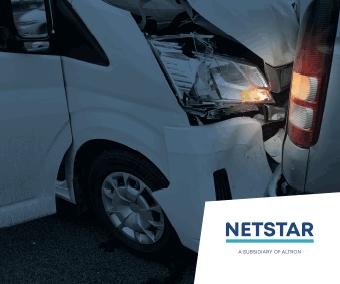When it comes to snake removal on site, part of the health and safety protocols for most corporate companies is that their staff may not make physical contact with snakes. This is great, as it significantly reduces the risks of a bite to the handler. Treating a serious snakebite is expensive and costs between R100,000.00 – R1,000,000.00.
If snake removers are properly trained and the correct snake handling equipment is available on site, there is absolutely no need for the snake remover to touch a venomous snake or catch it by the tail. There should be no compromise when it comes to the safety of the snake removers.
Snake handling equipment should only be used by the certificated snake removers on site. These snake removers would have undergone a snake awareness, first aid for snakebite and venomous snake handling course, teaching them how to safely remove and relocate venomous snakes found on site.
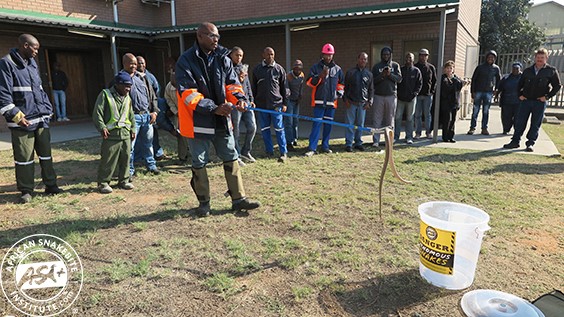
Choosing snake handling equipment can be difficult, as there are a lot of options on the market. Below are a few important factors that go into making an educated decision.
SNAKE TONGS:
If you are looking at buying snake tongs, what length are you comfortable with? In other words, what distance from a venomous snake would you be comfortable with? Most people jokingly tell us that 20m would work, but this is impractical. We highly recommend a 1.5 m tong for anyone who has done their first snake removal course and is inexperienced in removing snakes. You can handle anything from a 30cm Mozambique Spitting Cobra to a 2.5 m Black Mamba with a 1.5 m tong. They are short enough (compared to the 2m option) to still do removals in confined spaces like houses and workshops and fit comfortably in a small car. They are also long enough to keep you a safe distance from the sake, if caught in the right manner.
Experienced snake removers and snake parks generally make use of 1m tongs – mainly because they work in the close confines of snake tanks and these tongs work well for that. They also often need to neck snakes in snake parks and the longer tongs are then impractical. Necking is not something that should be done on site.
2m tongs are great for places like game lodges, where they need the length to remove snakes from thatch roofs or from under beds.
What to look out for:
Quality – make sure you’re buying a decent set of tongs. There are a lot of cheap Chinese imports available from various places and these can be more of a hazard than a help.
Make sure the trigger section closes completely and doesn’t jam. Purchase a tong with at least a 3cm lip on the upper jaw section – this makes a huge difference to removals as you don’t pinch the snake, and it makes working with larger bodied snakes much easier than those with a short lip.
Avoid heavy tongs, and tongs with metal rods underneath them – the snakes just wrap their tails around this.
Tongs are an investment and if they are well looked after, they will last you many years. Care for your tongs and do not drop them onto concrete floors from trees or roofs.
(In the end, you could spend a bit more on quality tongs or hundreds of thousands of Rand in medical fees after a bite).
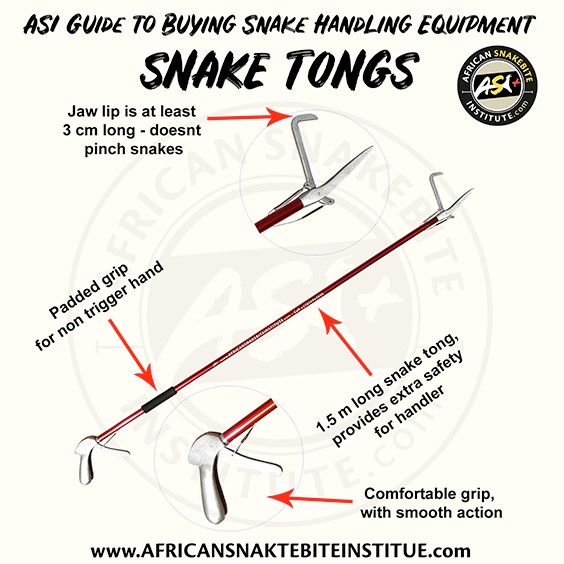
SNAKE HOOKS:
Snake hooks are pretty straight forward and work really well on the adders. Make sure the “U” of the hook will be big enough for a decent sized snake. The “V” hooks generally don’t work well for large adders. The experienced snake handlers use hooks to ‘hook and tail’ a snake, and in that scenario any hook will work. Some handlers even use tongs for this. Hooking and tailing is not advisable on site.
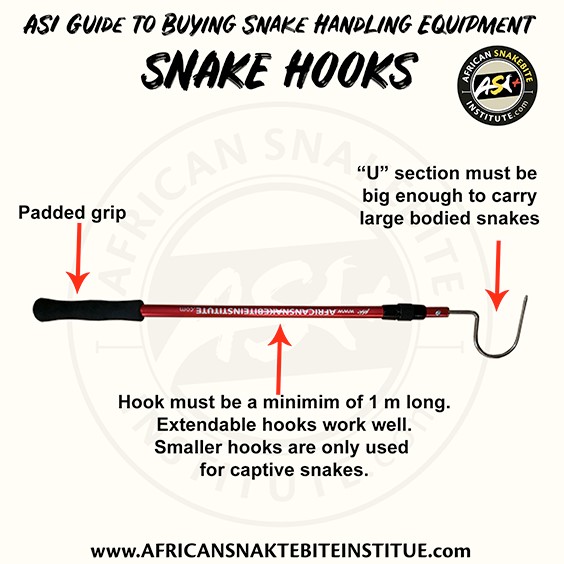
SNAKE TUBES:
We make extensive use of snake tubes, both on our courses and for removals. They work well to contain and safely transport venomous snakes. The snakes generally see the darkness of the tube as an escape route and are easily guided into the tube. When buying a tube, make sure it’s obviously marked, and has ventilation holes in the lid (usually covered by foam for spitting snakes) and has a decent handle. Holes down the sides of the tube are not advisable as they let light into the tube.
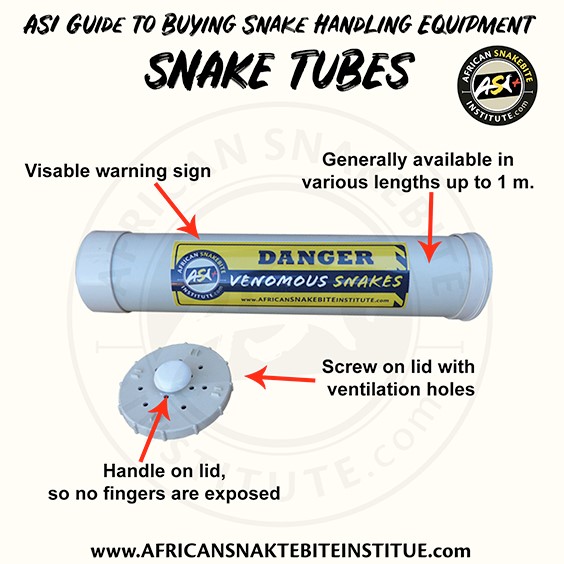
SNAKE BUCKETS:
The other container we make use of is a snake bucket. We prefer the transparent ones, so you can see what the snake is doing. Crumpled newspaper can be put in the bottom of the bucket for the snake to hide under. Avoid square or rectangular tubs. As soon as you put a snake in one of these it finds a corner and goes up and comes straight out. When buying a snake bucket, make sure it’s clearly marked with a “venomous snake” sticker, has a central grip on the lid (to avoid bites to the fingers), has clip closed handles and has ventilation holes. The 70 litre or 50 litre buckets are preferred as you can fit almost any sized snake in them.
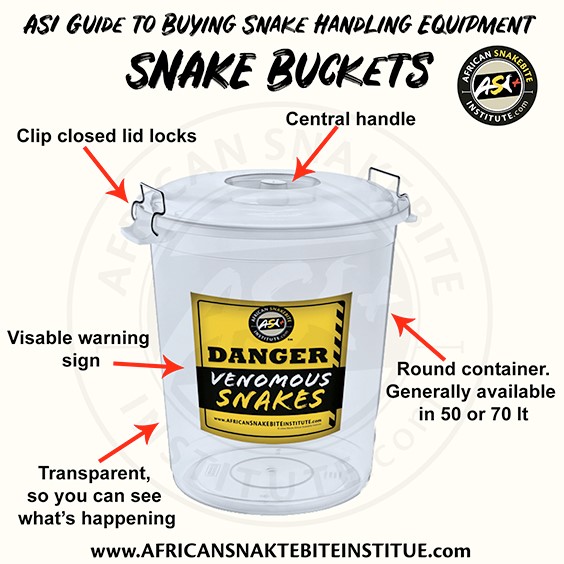
SNAKE BAGS:
Avoid snake bags. Snakes are capable of biting through bags and we’ve seen too many incidences of this to recommend the use of bags.
EYE PROTECTION:
Eye protection is vital for removals in areas where spitting snakes are known to occur. Venom in the eyes is extremely painful and not worth the risk. If you want to make use of goggles (or spoggles as they’re sometimes called) make sure you purchase ones that seal around the eye area. When snakes spit, they aim for the face and with a small bit of a sweat, the venom that lands on the forehead may run down into the eyes. Also make sure the goggles don’t fog up when wearing them.
The other option is a full-face mask – these work well as they protect the whole face.
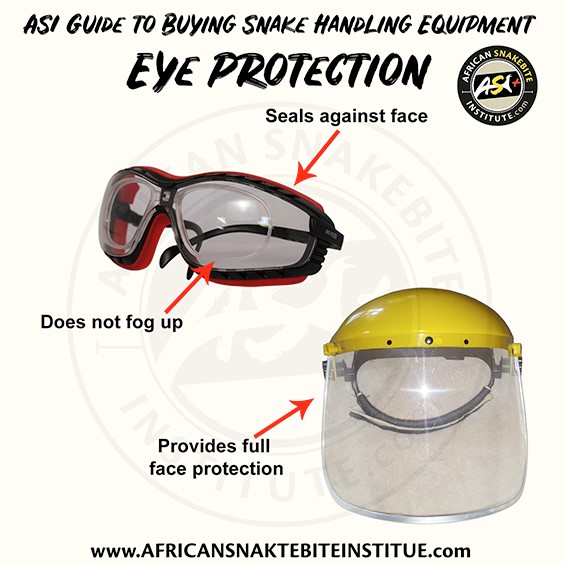
SNAKE GAITERS:
There are a number of snake gaiters on the market, from entry level budget ones to high end lightweight gaiters. Gaiters offer leg protection, and this is advisable as 84% of snakebites are below the knee. Ideally you want to make sure they are comfortable, and if it’s possible, try them on. Those that are quick to put on are great for removal purposes, as one is usually in a hurry. Make sure they’ve been tested by a reputable company.
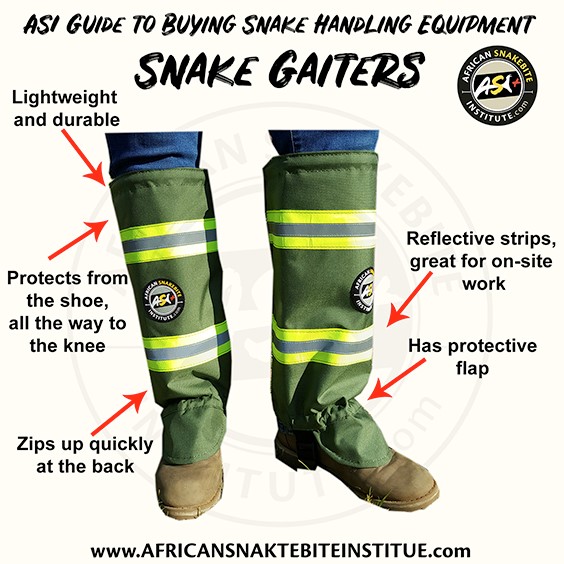
SNAKE GLOVES:
Leather gloves are not recommended for venomous snake removals. They are good for working with snakes like pythons and large mole snakes that can inflict nasty bites. If you want to use gloves for venomous snakes, then consider the Hexarmour Heavy Duty Snake Resistant Gloves. (Hercules 3180 R8E). These were designed by the medical industry for removal of used needles and are the most used gloves by venomous snake keepers.
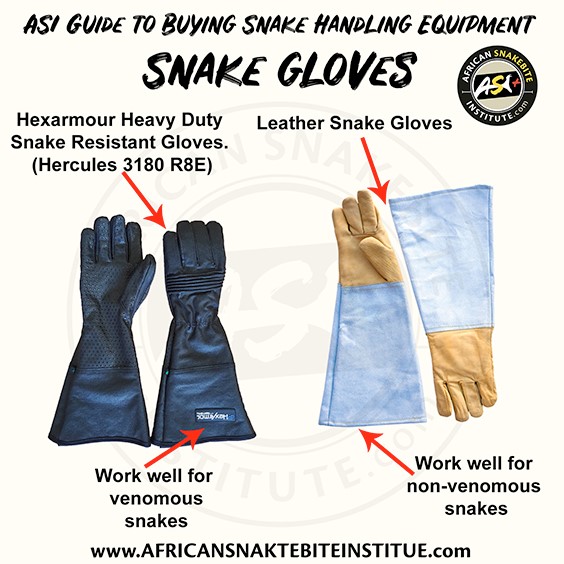
Find out more at www.africansnakebiteinstitute.com
Also view:

























